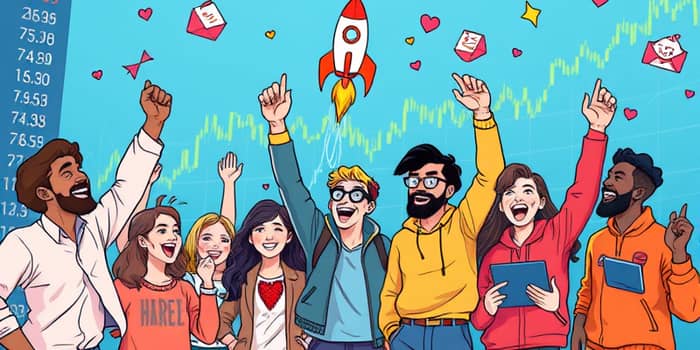
In the modern trading landscape, a new wave of market participants has emerged, wielding unprecedented influence. Ordinary individuals, armed with mobile apps and online communities, have shown they can reshape price dynamics in ways once thought impossible. This article dives into how these retail investors are powering select meme stocks to explosive highs in 2025, offering insights, case studies, and practical guidance for navigating this phenomenon.
The meme stock phenomenon first captured global attention in early 2021 when GameStop shares skyrocketed from $20 to over $300 in days. Powered by Reddit forums and social media, this surge was driven not by earnings or corporate strategy, but by viral attention and enthusiastic online followings. Retail traders coordinated massive buying sprees and triggered a historic short squeeze, forcing hedge funds to cover positions and driving prices ever higher.
Other names like AMC Entertainment and Bed Bath & Beyond quickly followed, each experiencing wild swings untethered from fundamentals. This period revealed how disconnect from company financial fundamentals could be overshadowed by collective sentiment, marking a turning point in how markets operate and who holds the power.
Several factors converge to fuel meme stock rallies today. Chief among them is the pervasive role of social platforms such as Reddit, X (formerly Twitter), and TikTok, where trading ideas spread like wildfire. User-generated content, influencer posts, and algorithmic boosts create feedback loops that amplify interest and trading volume in targeted names.
Meanwhile, the rise of commission-free trading apps has gamified the investment journey. Interfaces designed with badges, confetti animations, and easy-to-execute orders have lured a generation seeking both profit and entertainment. This blend of finance and fun has become a potent mix, described by some as the gamification of the investing experience.
GameStop remains the archetype. In early 2025, the company’s announcement to hold Bitcoin on its balance sheet sparked an 11.6% one-day jump in shares. Investors rallied around the narrative, reigniting the meme stock fire.
AMC Entertainment saw a resurgence as well, propelled by a flood of TikTok videos praising its turnaround strategy despite ongoing losses. Retail traders pushed the stock higher, showing that enthusiasm can outweigh traditional metrics like revenue or profit.
New entrants include Newsmax Media, which in 2025 became a flashpoint after a limited share offering and viral buzz. Despite posting a $72 million loss on $171 million in revenue, its stock leaped on rumors and retail expectations, illustrating how high volatility and crowd-driven momentum define modern market moves.
At the heart of meme investing lies a set of behaviors distinct from traditional stock picking. Traders often act on emotion, guided by community sentiment and fear of missing out. This can lead to collective action and rapid coordination, where a single viral post triggers thousands of buy orders within minutes.
However, the same forces that power meteoric rises can produce dramatic reversals. Prices detached from earnings face sudden sell-offs as sentiment shifts. To participate responsibly, investors should employ detailed risk management strategies:
The Securities and Exchange Commission (SEC) has scrutinized meme stock events, publishing reports on how online platforms and algorithmic trading can distort market integrity. Brokerages like Robinhood and Webull faced backlash when they temporarily restricted meme stock trading in 2021, highlighting operational risks and liquidity pressures.
Since then, regulators have debated reforms to improve transparency in short interest reporting and curb potential market manipulation. Industry stakeholders are calling for enhanced safeguards, from stricter margin requirements to more robust risk disclosures for retail clients.
Will the meme stock era continue? Many signs point to persistence. Retail participation remains elevated, with surveys indicating that nearly 20% of traders value the entertainment aspect as much as potential returns. As platforms refine their offerings and new social networks emerge, the conditions for viral rallies are unlikely to disappear.
Yet, a maturing ecosystem could introduce checks and balances. Enhanced regulatory oversight, improved platform risk controls, and greater investor education may temper extreme swings. The defining question is whether meme stocks will become a normalized segment of market activity or revert to episodic phenomena.
The meme stock phenomenon underscores the extraordinary influence of collective retail action. Empowered by technology, ordinary investors have shown they can challenge institutional norms and reshape market outcomes. This movement has democratized access but also introduced the growing power of retail as both an opportunity and a risk.
For those inspired to join, the lessons are clear: combine community-driven momentum with rigorous analysis and disciplined risk management. By acknowledging both the potential rewards and pitfalls, investors can navigate this dynamic landscape with confidence and resilience.
References













